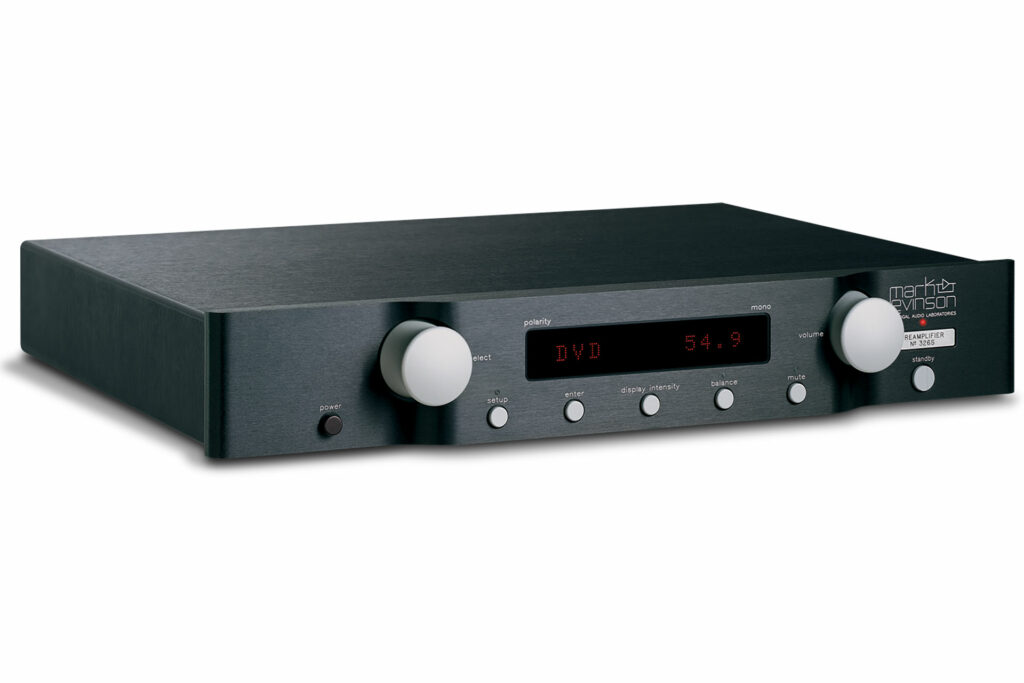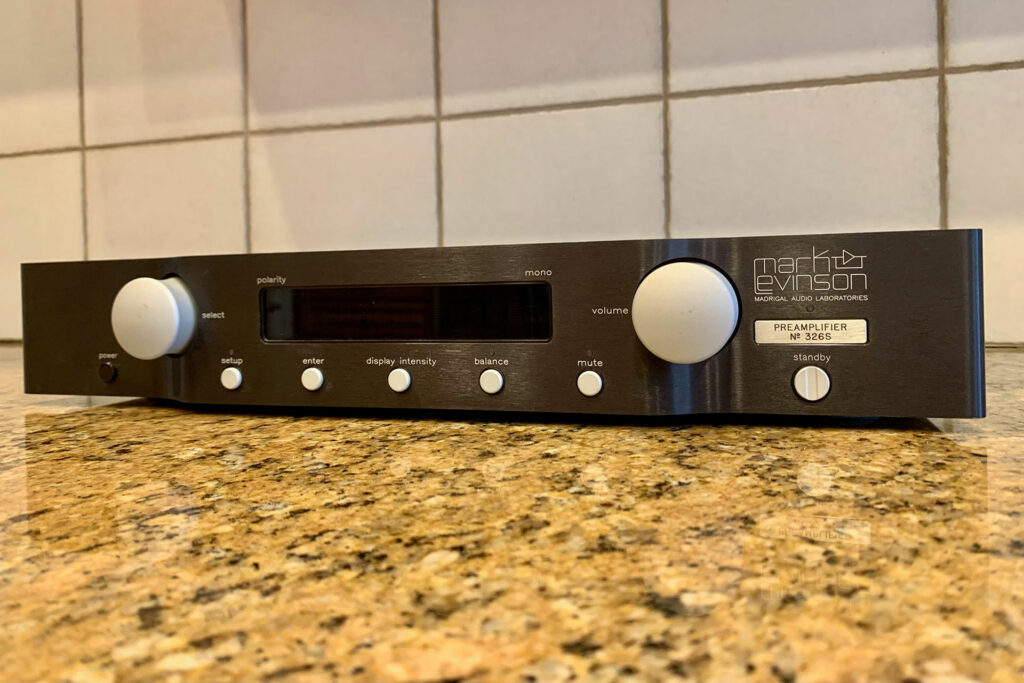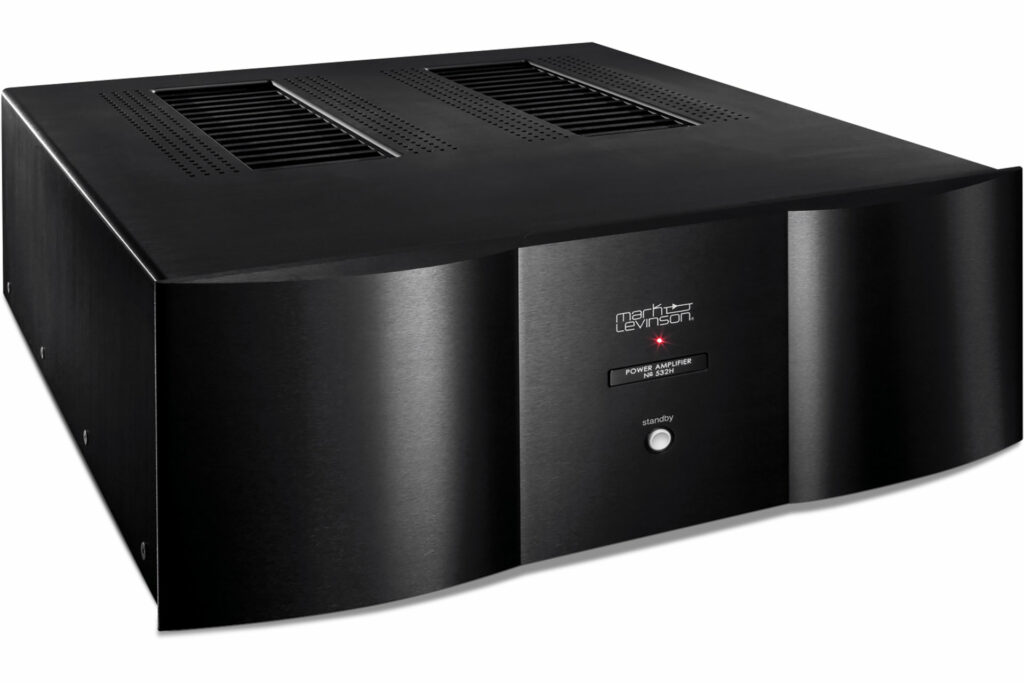Mark Levinson is a name synonymous with high-end luxury audio components for your home, as well as upmarket Lexus automobiles. The company’s long history dates back to 1972, when they released the first ultra-high-performance preamplifier, the JC-1. Since then, Mark Levinson has established itself as one of the premier manufacturers of audio equipment that many long to own. Their products offer exquisite build quality, timeless styling and performance that provide massive pride of ownership.
The Mark Levinson No. 326S stereo preamp occupies the middle slot of their preamp line, between the entry-level No. 320S ($8,000) and their reference No. 32 ($14,950). Externally, the Mark Levinson No. 326 and No. 320 share the same case, cosmetics and would be indistinguishable from each other were it not for the model number on the front. Internally, however things are quite different, with the Mark Levinson No. 326 getting many trickle-down features of the more expensive No. 32. The Mark Levinson No. 326 is a dual-mono, fully-balanced design like the No. 32, but lacking the external power supply.
So how does it sound? That’s what we are here for…

What Makes the Mark Levinson No. 326S Stereo Preamp So Special?
- Many features from the reference Mark Levinson No. 32 preamp have trickled down to the more affordable No. 326S. Features like a circuit board made from the same pricey Arlon material, discrete resister array volume control with .1dB resolution, a fully-balanced circuit design and an optional phono stage bring loads of performance.
- The Mark Levinson is elegantly simple in both design and operation. The No. 326S has a boatload of input options, including three XLR and four single-ended, enabling it to control even the most complicated systems. Each input can be custom-named for easy identification from the display, as well as having three independent gain settings to match for consistent volume levels across all sources. The preamp operation couldn’t be simpler, with one knob used for input selection and the other for volume control, just as it should be. The remote control is substantial, solid and befitting a component of this level.
- Build quality is typical Mark Levinson, meaning no corners were cut. The metal case-work is both beautiful and timeless. The trademark red display, gray knobs, and charcoal-colored case are instantly recognizable Mark Levinson. The feel of the materials exudes sophistication and luxury, as does the motion of the controls. Few companies in the audiophile world achieve tactile appeal more than does Mark Levinson. Just spin one of their volume controls once and you will know what I mean.
- Surround sound pass-through allows the No. 326S to happily coexist in your home theater with the right and left channels from your surround processor’s output to pass through the preamp untouched and on to the system amplifier. This is very handy, as many consumers combine their two-channel system with a home theater, even if most Mark Levinson clients are audio-only folks.
Why Should You Care About the Mark Levinson No. 326S Stereo Preamp?
The audiophile who is interested in the No 326S appreciates performance as well as craftsmanship. Many audiophiles relish the chase for the ultimate bang-for-the-buck performance without regard for qualities such as styling, materials, etc. And there is certainly nothing wrong with that endeavor. However, there are also many who want more than just great sound. They also want components that bring pride of ownership. Something that they look forward to touching, interacting with, or simply looking at. The Mark Levinson No. 326S is one of those components. That’s not to say that the No. 326S doesn’t bring the audio goods, because it does in spades. It also looks great while doing it, too.

Some Things You Might Not Like About the Mark Levinson No. 326S
- At the Mark Levinson No. 326S’s price, there is no internal DAC, which is not uncommon, as each component in your audiophile front end having its own serious power supply can be a very good thing. However, it does affect the cost of your system.
- There is no HDMI in this stereo preamp, as that is a rare feature, but it is creeping into more and more stereo preamps from companies like Classe Audio, NAD and others. Many mainstream sources are best connected via HDMI.
- The Mark Levinson No. 326S doesn’t have room correction. Other AV preamps above and below this price point offer such digital technology, but this is a purely analog preamp, thus if you wanted to use, say, Trinnov room correction, that would need to be done via another separate component and, again, at additional cost. Digital room correction has gotten better and better in the modern era, but this preamp is more in the old school, do-one-thing-right category, and that it does well.
Listening to the Mark Levinson No. 326S Preamp…
My current system consists of Rockport Avior II speakers, Parasound JC1 mono amps, an Ayre QB-9 DSD Twenty DAC and a Lumin U1 mini streamer. It’s a simple system, but all of the components are fairly high-end and let me hear what each component brings to, or detracts from, the music. When I inserted the No. 326S into the system, it was clearly noticeable.
I’m a huge Dire Straits fan, and luckily their records are extremely well-recorded, which is why it’s no surprise that so many reviewers reference their tracks, as I am about to do. Brothers in Arms is a classic album that doesn’t have a bad track on it. One of my favorite songs from this album, “Ride Across the River,” sounded more spacious and more defined through the No.326S. The song is what I would consider sparse, in the sense that the various instruments are rarely occupying the same space at the same time; they all stand on their own. The drums do a melodic slow pan across the soundstage from left to right, ending with a single deep kick. The location of each drum was solidly anchored in space, both horizontally and vertically, bringing a rhythmic circular motion to the music. The details of the drum from impact to resonance to decay were all in abundance. The kick drum in particular dug deeper and had more snap than I have heard in my system without the No. 326S. Mark Knopfler’s vocals floated in front of the rest of the soundstage with reverb, which was even more obvious. The Mark Levinson was masterful at allowing fine detail to come through, but not over-accentuating it. Everything was natural, with detail that allows the listener to peer as deeply into the music as they want, or they can take a step back and just enjoy the music as a cohesive performance.
Nils Lofgren is another favorite of mine, and his Acoustic Live recording of “Keith Don’t Go” is a test of any high-performance audiophile system. It’s an outstanding recording of Lofgren’s voice, his guitar and little else. “Crystalline” is a word that comes to mind when I hear the strings of his guitar. With lesser equipment, the attack of the small strings can sound aggressive to downright painful. Not so with the Mark Levinson No. 326S preamp in the loop. It preserves all of the instrument’s detail, without the harshness that would make the lister want to turn the volume down. The acoustic environment of the recording is extremely well-preserved, with echo, reverb and all of other spatial cues one experiences at a live performance. All of these were preserved convincingly when passing through the No. 326S, which puts the listener into the venue. This is what makes owning a high-performance audio system so magical.
Will the Mark Levinson No. 326S Preamp Hold Its Value?
Mark Levinson is one of the most well-respected names in the audiophile business, and has been for over a long period of time. The list of world-class audiophile products that the brand has produced is long and distinguished. They build gear that sounds fantastic and looks amazing. Yes, I’m a bit of a fanboy. Simple, high-performance, straightforward analog two-channel preamps are not going away anytime soon, in my opinion. Ones that are particularly well done, like the Mark Levinson No. 326S, can elevate a system like no other component, with the possible exception of a cutting-edge DAC. This is a product that you can invest in and feel good about it.
What is the Competition for the Mark Levinson No. 326S Stereo Preamp?
There is lots of excellent preamp competition in this price range, ranging from simple preamps to more complex units. What you will find is that, when you get to this level, your personal preferences are usually the deciding factor, as there will be more similarities than differences in your options.
If you want to stay with a solid-state preamp, then the Pass Labs XP-22 at $9,500 (read the review) is an excellent option to consider, with much of the same pedigree as the Mark Levinson. Nelson Pass rightfully gets a lot of the love for his namesake brand of audiophile electronics, but it is Wayne Colburn who designs their excellent stereo preamps and phono stages. The Pass Labs XP-22 is also a simple stereo preamp with a gorgeous build quality and two-chassis (separate power supply) design. As with the No. 326S, there is no DAC, HDMI or room correction in the XP-22. Both are a window into the music on your recordings, thus they don’t bring any coloration, or “house sound” as some people call it, to your system, which is good.
The Bricasti M20 at $12,500 is another-highly regarded preamp, but a relative newcomer, without the history of either the Mark Levinson or the Pass. Bricasti products look a lot like Mark Levinson physically. Their gear is simply excellent, as their linage is oddly sort of related to Mark Levinson, in that they have ties back to Lexicon. Today, Bricasti is a powerhouse in the pro audio world, having run with the idea of making the best reverb unit in the world, as Lexicon did in the past. Their audiophile electronics are simply stellar and comparable to brands that cost many, many times more. Bricasti is a bit of a very high-end audiophile sleeper.
If you want to consider a tube-based preamp, the Audio Research LS-28SE at $10,000 is a worthy contender. Really good tubes have a little bit more of a sound than excellent solid-state preamps, but ARC is likely the least colored on that list. Their track record of long-time service is truly impressive. They will restore any audiophile product that they’ve ever made right in Minnesota. That’s really impressive and a good way to keep the value high, long-term.

Final Thoughts on the Mark Levinson No. 326S Preamplifier…
The Mark Levinson No. 326S preamplifier is a fantastic piece of audiophile gear. It lets music flow in a way that will keep you engaged and rediscovering your music collection for years to come. With a Mark Levinson No. 326S in your system, you will likely discover pleasant but new musical surprises in recordings you’ve heard a hundred times.
If you’re in the mood for critical listening and want to dissect music with a scalpel, the Mark Levinson No. 326S will be the microscope for you to get just that much closer to the sound on your musical sources. If you want to kick back with a glass of smooth bourbon, turn on some chill music and forget about the terrible day you had in the office, the Mark Levinson No. 326S is there to help melt away the stress. It’s the type of component that you can build an entire system around and keep for a very long time. If you can’t tell already, I’m quite smitten with this preamp. So much so that I purchased the review unit. Yes, that’s a cliché ending to a product review, but it is also the highest form of praise. Give one a listen and don’t be shocked if you too are cutting a check, right then and there.



